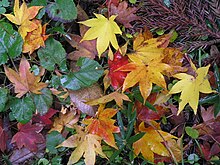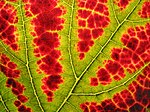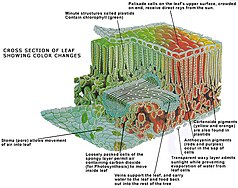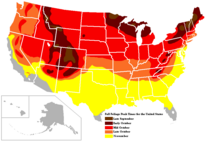When Do The Leaves Start Changing Colors

Autumn leafage color is a phenomenon that affects the normal green leaves of many deciduous trees and shrubs past which they have on, during a few weeks in the autumn season, various shades of yellow, orange, cherry, imperial, and brown.[1] The miracle is usually chosen fall colours [2] or fall leaf [3] in British English language and fall colors,[4] autumn foliage, or simply leafage [v] in American English.
In some areas of Canada and the United states of america, "leaf peeping" tourism is a major contribution to economical activity. This tourist activity occurs between the beginning of colour changes and the onset of leaf fall, normally around September and October in the Northern Hemisphere and April to May in the Southern Hemisphere.
Chlorophyll and the light-green/yellow/orange colors [edit]

In this leaf, the veins are still green, while the other tissue is turning red. This produces a fractal-like design

A North American leaf with multiple colors beyond information technology

Cross-department of a leaf showing color changes
A green leafage is green because of the presence of a pigment known as chlorophyll, which is within an organelle chosen a chloroplast. When abundant in the leafage's cells, as during the growing season, the chlorophyll's dark-green colour dominates and masks out the colors of any other pigments that may exist present in the foliage. Thus, the leaves of summer are characteristically dark-green.[6]
Chlorophyll has a vital function: information technology captures solar rays and uses the resulting free energy in the industry of the plant's food – simple sugars which are produced from water and carbon dioxide. These sugars are the ground of the plant's nourishment – the sole source of the carbohydrates needed for growth and development. In their food-manufacturing process, the chlorophylls break down, thus are being continually "used up". During the growing flavour, however, the plant replenishes the chlorophyll so that the supply remains high and the leaves stay green.
In tardily summer, with daylight hours shortening and temperatures cooling, the veins that acquit fluids into and out of the leaf are gradually airtight off as a layer of special cork cells forms at the base of operations of each leaf. Equally this cork layer develops, h2o and mineral intake into the foliage is reduced, slowly at start, and then more quickly. During this time, the amount of chlorophyll in the leaf begins to decrease. Often, the veins are yet green after the tissues between them have almost completely changed color.
Chlorophyll is located in the thylakoid membrane of the chloroplast and information technology is composed of an apoprotein forth with several ligands, the nearly important of which are chlorophylls a and b. In the autumn, this complex is cleaved down. Chlorophyll degradation is idea to occur first. Research suggests that the beginning of chlorophyll deposition is catalyzed past chlorophyll b reductase, which reduces chlorophyll b to vii‑hydroxymethyl chlorophyll a, which is then reduced to chlorophyll a.[vii] This is believed to destabilize the complex, at which point breakup of the apoprotein occurs. An important enzyme in the breakdown of the apoprotein is FtsH6, which belongs to the FtsH family of proteases.[viii]
Chlorophylls degrade into colorless tetrapyrroles known as nonfluorescent chlorophyll catabolites.[9] Every bit the chlorophylls degrade, the subconscious pigments of yellowish xanthophylls and orange beta-carotene are revealed.
Pigments that contribute to other colors [edit]

Autumn coloration at the Kalevanpuisto park in Pori, Finland.
Carotenoids [edit]
Carotenoids are nowadays in the leaves throughout the year, only their orange-yellow colors are unremarkably masked by dark-green chlorophyll.[6] Equally autumn approaches, sure influences both inside and outside the plant cause the chlorophylls to be replaced at a slower rate than they are being used upwards. During this period, with the full supply of chlorophylls gradually dwindling, the "masking" effect slowly fades away. Then other pigments nowadays (forth with the chlorophylls) in the leafage's cells begin to evidence through.[6] These are carotenoids and they provide colorations of yellow, brown, orange, and the many hues in between.
The carotenoids occur, along with the chlorophyll pigments, in tiny structures called plastids, within the cells of leaves. Sometimes, they are in such affluence in the leaf that they give a found a yellow-dark-green color, even during the summer. Usually, notwithstanding, they become prominent for the start time in autumn, when the leaves begin to lose their chlorophyll.
Carotenoids are mutual in many living things, giving feature color to carrots, corn, canaries, and daffodils, as well as egg yolks, rutabagas, buttercups, and bananas.
Their brilliant yellows and oranges tint the leaves of such hardwood species as hickories, ash, maple, xanthous poplar, aspen, birch, black cherry, sycamore, cottonwood, sassafras, and alder. Carotenoids are the ascendant pigment in coloration of virtually 15-xxx% of tree species.[6]
Anthocyanins [edit]
The reds, the purples, and their composite combinations that decorate autumn foliage come from some other group of pigments in the cells called anthocyanins. Unlike the carotenoids, these pigments are not present in the leaf throughout the growing season, but are actively produced towards the finish of summer.[6] They develop in tardily summer in the sap of the cells of the leaf, and this evolution is the outcome of complex interactions of many influences – both inside and outside the plant. Their germination depends on the breakdown of sugars in the presence of bright light as the level of phosphate in the foliage is reduced.[x]
During the summer growing season, phosphate is at a high level. It has a vital role in the breakdown of the sugars manufactured by chlorophyll, only in the fall, phosphate, along with the other chemicals and nutrients, moves out of the leaf into the stem of the institute. When this happens, the sugar-breakdown process changes, leading to the production of anthocyanin pigments. The brighter the calorie-free during this menstruum, the greater the production of anthocyanins and the more than brilliant the resulting color display. When the days of fall are bright and cool, and the nights are chilly but non freezing, the brightest colorations commonly develop.
Anthocyanins temporarily colour the edges of some of the very young leaves as they unfold from the buds in early spring. They too give the familiar colour to such common fruits as cranberries, red apples, blueberries, cherries, strawberries, and plums.
Anthocyanins are present in about 10% of tree species in temperate regions, although in certain areas – most famously northern New England – upwardly to 70% of tree species may produce the pigment.[vi] In autumn forests, they appear vivid in the maples, oaks, sourwood, sweetgums, dogwoods, tupelos, ruby copse, and persimmons. These same pigments often combine with the carotenoids' colors to create the deeper orange, peppery reds, and bronzes typical of many hardwood species.
Cell walls [edit]
The dark-brown color of leaves is not the result of a pigment, but rather prison cell walls, which may be evident when no coloring paint is visible.[6]
Function of autumn colors [edit]
Deciduous plants were traditionally believed to shed their leaves in fall primarily because the high costs involved in their maintenance would outweigh the benefits from photosynthesis during the wintertime period of depression light availability and cold temperatures.[11] In many cases, this turned out to be oversimplistic – other factors involved include insect predation,[12] water loss, and damage from high winds or snowfall.
Anthocyanins, responsible for red-purple coloration, are actively produced in autumn, but not involved in leaf-driblet. A number of hypotheses on the role of pigment production in leaf-drop accept been proposed, and generally autumn into two categories: interaction with animals, and protection from nonbiological factors.[6]
Photoprotection [edit]
According to the photoprotection theory, anthocyanins protects the leafage against the harmful effects of light at low temperatures.[13] [14] The leaves are near to fall, and then protection is not of extreme importance for the tree. Photo-oxidation and photoinhibition, however, especially at low temperatures, make the process of reabsorbing nutrients less efficient. By shielding the foliage with anthocyanins, according to the photoprotection theory, the tree manages to reabsorb nutrients (especially nitrogen) more efficiently.
Coevolution [edit]

According to the coevolution theory,[xv] the colors are alert signals to insects like aphids that utilize trees as a host for the wintertime. If the colors are linked to the amount of chemic defenses confronting insects, then the insects will avoid reddish leaves and increase their fitness; at the aforementioned time, trees with cerise leaves have an advantage considering they reduce their parasite load. This has been shown in the instance of apple copse where some domesticated apple varieties, unlike wild ones, lack ruby-red leaves in autumn. A greater proportion of aphids that avoid apple tree trees with blood-red leaves manage to grow and develop compared to those that do non.[sixteen] A trade-off, moreover, exists between fruit size, leaf color, and aphids resistance as varieties with blood-red leaves take smaller fruits, suggesting a toll to the production of red leaves linked to a greater need for reduced aphid infestation.[16]
Consistent with cherry-red-leaved trees providing reduced survival for aphids, tree species with brilliant leaves tend to select for more specialist aphid pests than do trees lacking brilliant leaves (autumn colors are useful only in those species coevolving with insect pests in fall).[17] Ane study found that simulating insect herbivory (foliage-eating damage) on maple trees showed earlier red coloration than copse that were non damaged.[18]
The coevolution theory of autumn colors was proposed by Westward. D. Hamilton in 2001 as an example of evolutionary signalling theory.[17] With biological signals such as ruddy leaves, it is argued that considering they are costly to produce, they are usually honest, and then signal the true quality of the signaller with low-quality individuals being unable to fake them and crook. Autumn colors would be a signal if they are costly to produce, or be impossible to fake (for instance if fall pigments were produced by the same biochemical pathway that produces the chemical defenses against the insects).[ commendation needed ]
The modify of leaf colors prior to autumn have too been suggested every bit adaptations that may help to undermine the cover-up of herbivores.[xix]
Many plants with berries concenter birds with specially visible berry and/or foliage color, particularly bright red. The birds get a meal, while the shrub, vine, or typically small tree gets undigested seeds carried off and deposited with the birds' manure. Poison ivy is particularly notable for having brilliant-ruddy leaf drawing birds to its off-white seeds (which are edible for birds, only non about mammals).
Allelopathy [edit]
The bright red autumn color of some species of maple is created by processes split up from those in chlorophyll breakdown. When the tree is struggling to cope with the energy demands of a irresolute and challenging season, maple trees are involved in an additional metabolic expenditure to create anthocyanins. These anthocyanins, which create the visual ruby-red hues, have been constitute to aid in interspecific contest by stunting the growth of nearby saplings (allelopathy).[twenty]
Tourism [edit]
Although some autumn coloration occurs wherever deciduous trees are found, the most brightly colored autumn foliage is institute in the northern hemisphere, including most of southern mainland Canada, some areas of the northern United states of america, Northern and Western Europe n of the Alps, the Caucasus region of Russia near the Black Sea, and Eastern Asia (including much of northern and eastern Cathay, and as well equally Korea and Japan).[21] [22]
In the southern hemisphere, colorful autumn foliage tin can be observed in southern and central Argentina, the s and southeast regions of Brazil, and southeastern Commonwealth of australia (including Tasmania).[23]
Climate influences [edit]
Compared to Western Europe (excluding Southern Europe), North America provides many more arbor species (more 800 species and about 70 oaks, compared to 51 and three, respectively, in Western Europe)[24] which adds many more different colors to the spectacle. The master reason is the unlike outcome of the Water ice ages – while in North America, species were protected in more southern regions along north–south ranging mountains, this was not the case in much of Europe.[25]
Global warming and ascent carbon dioxide levels in the temper may delay the usual autumn spectacle of changing colors and falling leaves in northern hardwood forests in the hereafter, and increase forest productivity.[26] Specifically, higher autumn temperatures in the Northeastern Us is delaying the color change.[27] Experiments with poplar copse showed that they stayed greener longer with higher COii levels, contained of temperature changes.[26] Even so, the experiments over two years were too brief to indicate how mature forests may be affected over time. Other studies using 150 years of herbarium specimens found more than a one calendar month delay in the onset of autumn since the 19th century, and constitute that insect, viral, and drought stress tin can also affect the timing of autumn coloration in maple trees.[27] [28] Also, other factors, such as increasing ozone levels close to the ground (tropospheric ozone pollution), tin can negate the beneficial effects of elevated carbon dioxide.[29]
-

English country lane in the autumn
-

Fall foliage colour and Mount Fuji with snow seen from Lake Kawaguchi, Nihon.
-

Late fall with brown dominating
-

References [edit]
![]() This article incorporates public domain fabric from the United States Regime document: "the USDA Forest Service".
This article incorporates public domain fabric from the United States Regime document: "the USDA Forest Service".
- ^ "The Science of Color in Autumn Leaves". usna.usda.gov. United States National Arboretum. October 6, 2011. Archived from the original on January 11, 2018. Retrieved June 18, 2015.
- ^ Wade, Paul; Arnold, Kathy (September 16, 2014). "New England in the Autumn: Trip of a Lifetime - Telegraph". telegraph.co.u.k.. The Daily Telegraph. Retrieved June eighteen, 2015.
- ^ "BBC - Gardening - How to be a gardener - The gardening year - Autumn'due south theme". bbc.co.uk. BBC. September 17, 2014. Retrieved June 18, 2015.
- ^ "US Wood Service - Caring for the land and serving people". fs.fed.us. United States Forest Service. 2014. Retrieved June 18, 2015.
- ^ "MaineFoliage.com - Maine'southward Official Fall Foliage Website". MaineFoliage.com. MaineFoliage.com. 2013. Retrieved June xviii, 2015.
- ^ a b c d due east f grand h Archetti, Marco; Döring, Thomas F.; Hagen, Snorre B.; Hughes, Nicole M.; Leather, Simon R.; Lee, David Westward.; Lev-Yadun, Simcha; Manetas, Yiannis; Ougham, Helen J. (2011). "Unravelling the evolution of autumn colours: an interdisciplinary arroyo". Trends in Ecology & Evolution. 24 (three): 166–73. doi:10.1016/j.tree.2008.ten.006. PMID 19178979.
- ^ Horie, Y.; Ito, H.; Kusaba, M.; Tanaka, R.; Tanaka, A. (2009). "Participation of Chlorophyll b Reductase in the Initial Stride of the Deposition of Calorie-free-harvesting Chlorophyll a/b-Protein Complexes in Arabidopsis". Journal of Biological Chemistry. 284 (26): 17449–56. doi:10.1074/jbc.M109.008912. PMC2719385. PMID 19403948.
- ^ Zelisko, A.; Garcia-Lorenzo, Thousand.; Jackowski, G.; Jansson, South.; Funk, C. (2005). "AtFtsH6 is involved in the deposition of the light-harvesting complex Two during loftier-low-cal acclimation and senescence". Proceedings of the National Academy of Sciences. 102 (38): 13699–704. Bibcode:2005PNAS..10213699Z. doi:x.1073/pnas.0503472102. PMC1224624. PMID 16157880.
- ^ Hortensteiner, S. (2006). "Chlorophyll deposition during senescence". Almanac Review of Plant Biological science. 57: 55–77. doi:ten.1146/annurev.arplant.57.032905.105212. PMID 16669755.
- ^ Davies, Kevin Grand. (2004). Constitute pigments and their manipulation. Wiley-Blackwell. p. 6. ISBN978-1-4051-1737-1.
- ^ Thomas, H; Stoddart, J L (1980). "Leaf Senescence". Annual Review of Plant Physiology. 31: 83–111. doi:x.1146/annurev.pp.31.060180.000503.
- ^ Labandeira, C. C.; Dilcher, DL; Davis, DR; Wagner, DL (1994). "Ninety-seven million years of angiosperm-insect association: paleobiological insights into the meaning of coevolution". Proceedings of the National Academy of Sciences. 91 (25): 12278–82. Bibcode:1994PNAS...9112278L. doi:ten.1073/pnas.91.25.12278. PMC45420. PMID 11607501.
- ^ Lee, David; Gould, Kevin (2002). "Why Leaves Turn Ruddy". American Scientist. 90 (six): 524–531. Bibcode:2002AmSci..xc..524L. doi:10.1511/2002.vi.524.
- ^ Lee, D; Gould, K (2002). "Anthocyanins in leaves and other vegetative organs: An introduction". Advances in Botanical Enquiry. 37: 1–16. doi:10.1016/S0065-2296(02)37040-10. ISBN978-0-12-005937-nine.
- ^ Archetti, M; Brown, S. P. (June 2004). "The coevolution theory of autumn colours". Proc. Biol. Sci. 271 (1545): 1219–23. doi:10.1098/rspb.2004.2728. PMC1691721. PMID 15306345.
- ^ a b Archetti, Thousand. (2009). "Evidence from the domestication of apple for the maintenance of autumn colours past coevolution". Proceedings of the Purple Club B: Biological Sciences. 276 (1667): 2575–80. doi:x.1098/rspb.2009.0355. PMC2684696. PMID 19369261.
- ^ a b Hamilton, Due west. D.; Brownish, Southward. P. (2001). "Fall tree colours as a handicap signal". Proceedings of the Royal Club B: Biological Sciences. 268 (1475): 1489–93. doi:10.1098/rspb.2001.1672. PMC1088768. PMID 11454293.
- ^ Forkner, Rebecca E. (May ane, 2014). "Simulated herbivory advances autumn phenology in Acer rubrum". International Journal of Biometeorology. 58 (4): 499–507. Bibcode:2014IJBm...58..499F. doi:10.1007/s00484-013-0701-8. PMID 23832182. S2CID 24879283.
- ^ Lev-Yadun, Simcha; Dafni, Amots; Flaishman, Moshe A.; Inbar, Moshe; Izhaki, Ido; Katzir, Gadi; Ne'eman, Gidi (2004). "Plant coloration undermines herbivorous insect camouflage". BioEssays. 26 (ten): 1126–30. doi:10.1002/bies.20112. PMID 15382135.
- ^ (Frey & Eldridge, 2005)[ citation needed ]
- ^ "Pest Alert". South Dakota Land Academy. August 30, 1998. Archived from the original on Oct twenty, 2006. Retrieved November 28, 2006.
- ^ Altman, Daniel (November 8, 2006). "Fall foliage sets Japan afire". Taipei Times. Retrieved Nov 28, 2006.
- ^ Hutchinson, Carrie (March 2, 2019). "The 5 Best Places in Australia to See Autumn Colours". Qantas. Retrieved July 22, 2019.
- ^ Heinz Ellenberg, H. Ellenberg: Vegetation Mitteleuropas mit den Alpen: In ökologischer, dynamischer und historischer Sicht, UTB, Stuttgart; 5th edition, in High german, ISBN 3-8252-8104-3, 1996[ folio needed ]
- ^ "Botanik online: Pflanzengesellschaften - Sommergrüne Laub- und Mischlaubwälder" (in German). Academy of Hamburg Biology Server. Archived from the original on Oct half-dozen, 2014. Retrieved July 29, 2020.
- ^ a b Taylor, Gail; Tallis, Matthew J.; Giardina, Christian P.; Percy, Kevin East.; Miglietta, Franco; Gupta, Pooja S.; Gioli, Beniamino; Calfapietra, Carlo; Gielen, Birgit (2007). "Future atmospheric CO2 leads to delayed autumnal senescence". Global Change Biology. fourteen (2): 264–75. Bibcode:2008GCBio..14..264T. CiteSeerXten.1.one.384.1142. doi:10.1111/j.1365-2486.2007.01473.x.
- ^ a b Gibbens, Sarah (Nov 24, 2021). "Fall leaf was disrupted by climate change. It might be the new normal". Environment. National Geographic.
- ^ Garretson, Alexis; Forkner, Rebecca E. (2021). "Herbaria Reveal Herbivory and Pathogen Increases and Shifts in Senescence for Northeastern United States Maples Over 150 Years". Frontiers in Forests and Global Alter. four: 185. doi:10.3389/ffgc.2021.664763.
- ^ "Forests Could Benefit When Autumn Colour Comes Late". Newswise. Retrieved August 17, 2008.
Further reading [edit]
- Guy, Robert D.; Krakowski, Jodie (2003). "Autumn Colours – Nature's Canvas is a Silk Parasol" (PDF). Davidsonia. 14 (4): 111–20. Archived from the original (PDF) on October 19, 2013. Retrieved May 18, 2007.
External links [edit]
- Autumnal tints by Henry David Thoreau
- Identifying Mutual copse in Autumn by their colors
- Sanderson, Katharine (2007). "Why autumn leaves plough blood-red". Nature. doi:10.1038/news.2007.202.
Source: https://en.wikipedia.org/wiki/Autumn_leaf_color
Posted by: gasparhossing.blogspot.com

0 Response to "When Do The Leaves Start Changing Colors"
Post a Comment